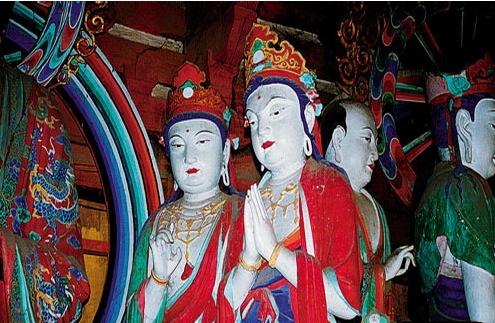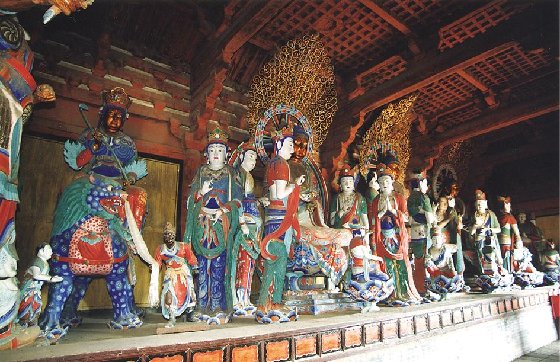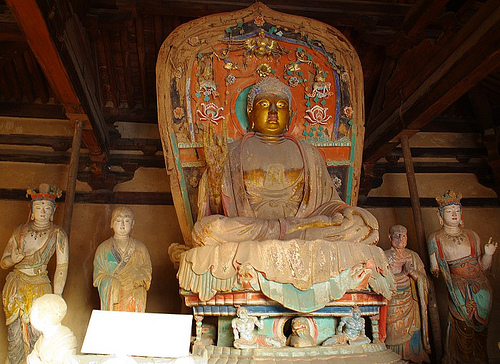
A pilgrimage through temples from Luoyang to Datong across China's Shanxi Province
(The
following outlines are taken from various online sources, the English
is of varying qualities. All the photos except the photos of statues on
this page were taken by me during the week August 7-14, 2009)
Luoyang 洛阳 / 洛陽 The original city of Luoyang was constructed by the Duke
of Zhou in the 11th century BC. It became the capital of the Zhou Dynasty in
770 BC. In AD 25, Luoyang became the capital of Eastern Han Dynasty. For
several centuries, Luoyang was the focal point of China. Luoyang was restored
to prominence when Emperor Wen of the Wei Dynasty declared it his capital in AD
220. The Jin Dynasty, successor to Wei, was also established in Luoyang. In AD
493 the Northern Wei Dynasty moved its capital from Datong to Luoyang.
Shaolin Temple. Founded in the 5th century, not very far from Luoyang, the
monastery has long been famous for its association with Chinese martial arts
and particularly with Shaolin Kung Fu, and it is surely the Buddhist
monastery best known to the Western world. It
was almost completely destroyed in 1928, when the warlord Shi Yousan set
fire to the monastery, destroying 90% of the buildings including many
manuscripts of the temple library. Attacked by red guards during the Cultural Revolution
(1966-), it stayed stripped and empty for many years. It is now a major
attraction for young martial arts enthusiasts, with practice fields and a
training center within the grounds. The Forest of Pagodas is the oldest surviving part of Shaolin Temple.
White Horse Temple 白马寺 was the first Buddhist temple to be founded in China,
established under the patronage of Emperor Ming in the Eastern Han capital
Luoyang in the year 68. Nothing remains from very ancient times.
Longmen Caves 龙门石窟 One of the great Buddhist cave sites, coming after Mogao and Yunhang. There are 2345 caves and niches, 2800 inscriptions, 43
pagodas and over 100,000 Buddhist images at the site. 30% of the caves date from
the Northern Wei Dynasty, 60% from the Tang Dynasty.
Zhenguo
Temple (镇国寺) was first built in 963 in the Northern Han Dynasty (951 - 979), Zhenguo
Temple is famous for the Ten- Thousand-Buddha Hall, which is one of the three
oldest timberworks in mainland China. Inside the temple there are eleven
sculptures that belong to the Five Dynasties period. Photography of them is not allowed. See Flikr photos / The China Guide photos
Shuanglin Temple (双林寺) was originally founded in the 6th century
during the Northern Wei period, although the present buildings date to the Ming
and Qing dynasties. It is notable for its collection of over two thousand
decorated clay statues dating from the 12th-19th centuries.

Photography of the statues is not allowed. Other photos from the Internet. The China Guide photos
Pingyao (平遥) is a township that lies
about 715 km from Beijing and 80 km from Taiyuan. During the Qing Dynasty,
Pingyao was a financial center of China. It is now renowned for its
well-preserved ancient city wall, and is a UNESCO World Heritage Site. More
than 300 sites in or near the city have ancient ruins. Preserved Ming- and
Qing-style residences number close to 4,000. The streets and storefronts inside the walls still
largely retain their historical appearance. The China Guide:_street_life / old_city_wall
Jinci Temple (晋祠寺 25 kilometers southwest of Taiyuan) is a stunning group of shrines, pagodas
and towers set among gardens with a 1,400 year history. The Hall of the Holy
Mother, the Double Wooden Bridge and the Xiandian Hall are regarded as the most
beautiful of the temples’ 100 or so buildings. Each was produced during a
different dynasty. The carved dragons on the wooden pillars of the Hall of the
Holy Mother are some of the oldest wood carvings in China.

The Song Dynasty stone maids are famous.
Tianlongshan 天龍山 ("Heavenly Dragon Mountain") Located near the summit of a towering massif which is located 40
kilometers southwest of Taiyuan City, are the Tianlongshan Grottoes 天龍山石窟. The existing grottos have 1,500 statues. 15 grottos were excavated
during the Tang Dynasty (618 -907). The grottos
excavated during the Eastern Wei Dynasty (534-550) are the most vivid.
Taiyuan (太原) The Shanxi Museum (山西博物馆) is closed on Mondays. Inside the city in an alley is Chongshan Temple崇善寺. Originally
built during the Tang Dynasty,
Ming dynasty renovations extended the site to make it the biggest
Buddhist
monastery in China. Today only one-fortieth of the complex
remains, including the Bell Tower, Da Bei hall and the colourful
frescos.
Along the way to Wǔtái Shān are the Tang Dynasty (618–907) era timber halls located at Foguang Temple (佛光寺)and Nanchan Temple (南禅寺).
Foguang Temple's East Hall (东大殿) was built in 857
AD, during the Tang Dynasty (618–907). According to architectural records, it
is the third earliest preserved timber structure in China.

Inside the hall are
more than twenty sculptures and murals on each wall that date from the Tang
Dynasty and later periods. The second oldest pagoda in China (after the Songyue
Pagoda), dating from the 6th century, is located in the temple grounds.

Photography is not allowed inside the hall.
Nanchan Temple's main hall is the earliest preserved timber-structured building in China, built
in the Tang Dynasty.

The sculptures of the Tang Dynasty are masterpieces.
Photography is not allowed.
The most impressive site is the renowned Yungang
Grottoes (云冈石窟), located
about 16 km south-west of Datong, in the valley of the Shi Li river at the
base of the Wuzhou Shan mountains, mainly constructed in the period between
460-525 AD. All together the site is composed of 252 grottoes with more than
51,000 Buddha statues and statuettes. After the decline of the Jin Dynasty, the northern parts
of China came under the control of the Northern Wei dynasty, ruled by a
proto-mongolic tribe called Tuoba. They made the city of Pingcheng, now known
as Datong, their capital in 398 AD. The Northern Wei early adopted Buddhism as their state
religion and launched the creation of the grottoes.
The work on this first period of carving, the caves now known as caves 16–20, lasted
until the year 465 AD. These each contain a single, enormous
seated Buddha that is a portrait of an emperor, indicating that the
emperors claimed to be "living Buddhas."
Beginning around the year 471 AD, in a
second construction phase that lasted until 494 AD, the twin caves 5/6, 7/8, and
9/10 as well as the caves 11, 12, and probably 13 were constructed under the
supervision and support of the imperial court. These are the most richly carved caves, that were subsequently colored.
The imperial patronage ended 494
AD with the move of the Wei court to the new capital of Luoyang. All other caves emerged under private
patronage in a third construction period, lasting until 525, when the
construction came to a final halt due to uprisings in the area.
The photos of Yungang: After a few views of the huge statues at the center , exposed to the open air, the photos in the slideshow begin at the late cave 40, and descend toward caves 16–20 and the more elaborate, painted caves, culminating in 5/6 and 7/8 where photography is not permitted.